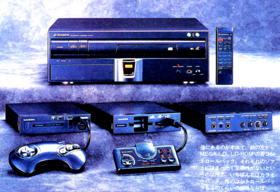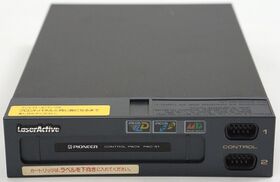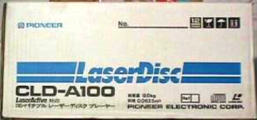LaserActive
From Sega Retro

| |||||||||||||||
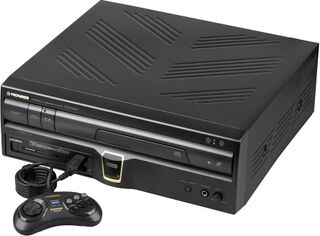
| |||||||||||||||
| LaserActive | |||||||||||||||
|---|---|---|---|---|---|---|---|---|---|---|---|---|---|---|---|
| Manufacturer: Pioneer | |||||||||||||||
| Variants: NEC PCE-LD1 | |||||||||||||||
| Add-ons: Sega PAC, NEC PAC, Karaoke PAC, Computer Interface PAC, 3D Goggle | |||||||||||||||
|
The LaserActive (パイオニアレーザーアクティブ) is a video game-compatible LaserDisc player designed and manufactured by Pioneer. Released in Japan and North America in late 1993, the system features interchangeable hardware expansions known as PACs, which enable compatibility with Mega Drive and Mega-CD games, PC Engine and PC Engine CD-ROM² games, and a new type of LaserDisc-based format: Sega Mega LD and NEC LD-ROM².
NEC produced a rebranded version of the system, the NEC PCE-LD1.[2][3]
Contents
Hardware
LaserDisc
The LaserActive plays all sizes of both standard compact disc and LaserDisc media, including CD Video and LaserKaraoke discs. Considered a mid-range player in terms of playback quality, inserting a Sega PAC or NEC PAC expands the hardware with advanced playback features like frame-by-frame view and multi-speed jogging.[4] The LaserActive cannot automatically switch between a disc's sides, and requires users to eject, flip, and re-insert discs halfway between most movies and software.
The system outputs in composite video (the format which all LaserDiscs are natively encoded in), and when playing video games, boasts superior video quality to both the Mega Drive and PC Engine's composite video output - particularly in regards to its comb filter. While the LaserActive supports DTS, it notably lacks the popular Dolby AC-3 surround sound capabilities found on later players, instead relying on software developers to encode spatial audio systems like RSS into their releases directly.
LaserActive games were specficially developed to take advantage of the video storage potential of LaserDisc media. Similar to how the popular LaserDisc-based arcade game Dragon's Lair used special technology to add an interactive layer to the video, Sega Mega LD and NEC LD-ROM² could do the same. These two formats were rebranded versions of Philips' LD-ROM format, adapted for each company's respective PAC. However, the format's generally 480i content had to be downsampled to 240p whenever developers wished to display additional on-screen graphics with their games (to match the resolution of the 16-bit hardware the format works with.)
PACs
The LaserActive is designed to be an expandable and widely-compatible system. In addition to its existing ability to play LaserDisc and LD-G formats, the system can be expanded with plug-in hardware modules called PACs (sometimes stylized as Packs.) PACs expand the system's capabilities, such as the Sega PAC giving the system the capabilities of a Sega Mega Drive and Sega Mega-CD combined, allowing for playback of additional formats such as CD-G. While PACs are generally region locked, Sega Mega LD and NEC LD-ROM² games are region free and will play on any NTSC system.
The PACs listed below are suffixed by (American model number/Japanese model number):
Sega PAC (PAC-S10/PAC-S1)
- Main article: Sega PAC.
The Sega PAC allows the system to play Sega Mega Drive, Sega Mega-CD, and Sega Mega LD games, in addition to CD-G media. Like it's counterpart, the NEC PAC, it also expands the LaserDisc functionality of the system by adding advanced playback features like frame-by-frame view and multi-speed jogging.[4]
While also fully compatible with the Power Base Converter, the accessory's plastic shell is too wide, resulting in it physically being unable to be inserted into the LaserActive. However, by positioning the system on the edge of a shelf or table, or by disassembling the Converter entirely, players can enjoy Master System games through the Sega PAC as well.[5] Unfortunately, the Sega 32X lacks compatibility with the PAC altogether.[6]
NEC PAC (PAC-N10/PAC-N1)
- Main article: NEC PAC.
The NEC PAC allows the system to play NEC PC Engine, NEC PC Engine CD-ROM², and NEC LD-ROM² games, in addition to CD-G media. Like it's counterpart, the Sega PAC, it also expands the LaserDisc functionality of the system by adding advanced playback features like frame-by-frame view and multi-speed jogging.[4]
Karaoke PAC (PAC-K10/PAC-K1)
- Main article: Karaoke PAC.
The Karaoke PAC allows the system to play LaserKaraoke media, and features karaoke-oriented inputs and controls.
Computer Interface PAC (PAC-PC1)
- Main article: Computer Interface PAC.
The Computer Interface PAC allows the system to be controlled by an NEC PC-98, IBM PC DOS, or Apple Macintosh personal computer[7], by way of a custom program authored to communicate via the PAC's 25-pin serial port. The PAC is the only Japan-exclusive peripheral for the system.
History
Released in Japan and the United States in late 1993, the LaserActive and its exclusive video game formats, Mega LD and LD-ROM², saw less than a few dozen releases, with limited support from developers and a software library of mixed quality.
Background
Pioneer had previously experimented with upgradable television sets with their SEED Television, which was sold alongside separate hardware expansion modules known as Packs. While most Packs offered additional audio and video functionality, Pioneer also released the Pioneer TV Video Game Pack SD-G5, which enabled play of Sega SG-1000 and Sega SC-3000 game cartridges, and the Pioneer TV Video Game Pack SD-R5, which enabled play of MSX game cartridges.
Development
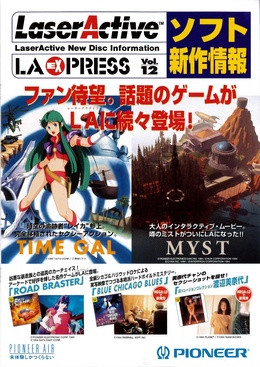
Approached by Pioneer to assemble a varied team of media artists to produce software for their upcoming LaserActive platform, Japanese ambient musician Jotaro Nonaka founded Multimedia Creators Network, notably adapting his own home into a recording studio and game development office. The group would go on to release three titles for the system: 1994's 3D Museum and Melon Brains: Exploring The Mind Of The Dolphin, and 1995's Goku, with a fourth title, UFO & ET, planned but ultimately cancelled.[8]
Release
The LaserActive was supported by LA Express, a promotional publication released by Pioneer which generated hype for the system and announced upcoming titles.
While seemingly exclusive to Japan and the United States, it appears the LaserActive and its games were officially imported to Canadian buyers through Pioneer Electronics of Canada, Inc.
Decline
The Pioneer LaserActive was not particularly successful or fondly remembered, partly because of its high price point, but mostly due to the subsequent failure of LaserDisc as a home video format. Developers equipped to produce new LaserDisc software were few and far between, and with its market already so limited, many potential developers were turned off from investing in an already-failing platform.
After the system's failure, Pioneer would reuse some of their LaserActive shell designs in future products; particularly, their standalone 3D headset adaptor was produced in a PAC shell, with its matching goggles designed as a spiritual successor to the system's 3D Goggle peripheral.[9]
Localised names
| Language | Localised Name | English Translation |
|---|---|---|
| English (US) | LaserActive | LaserActive |
| Japanese | パイオニアレーザーアクティブ | LaserActive |
List of games
- Main article: List of LaserActive games.
The following is a list of LaserActive games. 34 games were published for the system, produced on Sega Mega LD or NEC LD-ROM² formats, and released in Japan or the United States.
Sega Mega LD
- 3D Museum (1994)
- 3D Virtual Australia (1995)
- Back to the Edo (1994)
- Bi Ryojon Collection: Minayo Watanabe (1994)
- Bi Ryojon Collection Vol. 2: Yuko Sakaki (1995)
- Don Quixote: A Dream in Seven Crystals (1994)
- Dr. Paolo no Totteoki Video (1994)
- Ghost Rush! (1994)
- Goku (1995)
- The Great Pyramid (1993)
- Hi-Roller Battle (1993)
- Hyperion (1994)
- I Will: The Story of London (1993)
- J.B. Harold Blue Chicago Blues (1994)
- Melon Brains (1994)
- Pyramid Patrol (1993)
- Road Blaster (1995)
- Rocket Coaster (1993)
- Space Berserker (1993)
- Time Gal (1995)
- Triad Stone (1994)
- Virtual Cameraman (1993)
- Virtual Cameraman 2 (1994)
- Zapping Satsui (1994)
- Bi Ryojon Collection Vol. 3 (unreleased)[10]
- Legacy (unreleased)[10][11]
- Myst (unreleased)[10][12]
- Steel Driver (unreleased)[10][12]
- UFO & ET (unreleased)[10][13]
NEC LD-ROM²
- Akuma no Shinban (1993)
- Angel Mate (1993)
- Bi Ryojon Collection: Minayo Watanabe (1994)
- Bi Ryojon Collection Vol. 2: Yuko Sakaki (1995)
- Dora Dora Paradise (1994)
- Manhattan Requiem (1993)
- Quiz Econosaurus (1993)
- Vajra (1993)
- Vajra Ni (1994)
- Zapping Satsui (1994)
- Bi Ryojon Collection Vol. 3 (unreleased)[10]
- NHK Conversational Chinese (unreleased)[10][12]
- Ozone (I Will: The Story of London) (unreleased)[10]
- UFO & ET (unreleased)[10][13]
Magazine articles
- Main article: LaserActive/Magazine articles.
Promotional material
- Main article: LaserActive/Promotional material.
Physical scans
Logos
Technical specifications
- Main article: LaserActive/Technical specifications.
External links
- Laseractive Preservation Project fansite
- The Virtual LaserActive Museum fansite at CYBERROACH.COM
- LaserActive at LaserDisc Archive
- LaserActive at Video Game Console Library
References
- ↑ Beep! MegaDrive, "October 1993" (JP; 1993-09-08), page 18
- ↑ http://www.laserdiscarchive.co.uk/laserdisc_archive/nec/nec_pce-ld1/nec_pce-ld1.htm
- ↑ http://www.rfgeneration.com/PHP/gethwinfo.php?ID=J-053-H-00070-A
- ↑ 4.0 4.1 4.2 https://laseractive.wordpress.com/about-the-laseractive/
- ↑ File:LaserActive PowerBaseConverter.jpg
- ↑ https://www.youtube.com/watch?v=lap39N4YrN4
- ↑ https://laseractive.wordpress.com/image-gallery/#jp-carousel-338
- ↑ https://laseractive.wordpress.com/interviews/ (Wayback Machine: 2020-11-11 21:40)
- ↑ File:LaserActive PAC reusedshell.jpg
- ↑ 10.0 10.1 10.2 10.3 10.4 10.5 10.6 10.7 10.8 https://laseractive.wordpress.com/laseractive-release-database/
- ↑ https://laseractive.wordpress.com/2012/10/26/cancelled-laseractive-game-legacy/ (Wayback Machine: 2019-01-04 21:37)
- ↑ 12.0 12.1 12.2 https://www.queenmeka.com/laseractive-les-prototypes/
- ↑ 13.0 13.1 https://laseractive.wordpress.com/interviews/
NEC Retro has more information related to LaserActive
|
| LaserActive | |
|---|---|
| Topics | Technical specifications | List of games | Magazine articles | Promotional material | LA Express | Pioneer LDC | Multimedia Creators Network |
| Hardware | Japan | United States NEC PCE-LD1 |
| Add-ons | Sega PAC | NEC PAC | Karaoke PAC | Computer Interface PAC |
| Controllers | Control Pad | Turbo Pad | Remote Control Unit | Computer Interface Pack Remote Control Unit |
| Accessories | 3D Goggle | 3D Goggle Adaptor | Control Pad Extension Cord | Turbo Pad Extension Cord | Karaoke Microphone | Karaoke Microphone (Key Control) |
| Sega Mega-CD | |
|---|---|
| Topics | Technical specifications | History | Magazine articles | Promotional material |
| Hardware | Mega CD (Asia | North America | Western Europe | Eastern Europe | South America | Australasia | Africa) Sega Multi-Mega (Asia | North America | Europe | South America | Australasia) Wondermega | LaserActive | CSD-G1M |
| Misc. hardware | CD BackUp RAM Cart | Mega-CD Karaoke | Pro CDX |
| Development tools | SNASM Mega-CD | PsyQ Mega-CD SDK | PSY-Q CD Emulation System (Mega-CD) |
| Unreleased hardware | Game Genie |
